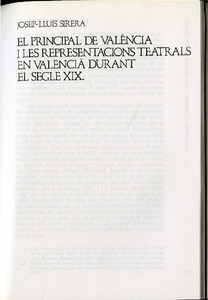El Principal de València i les representacions teatrals en valencià durant el segle XIX
Metadata
Show full item record
Estudis escènics: quaderns de l'Institut del Teatre. 1984, Núm. 24
Document typeArticle
Abstract
<p>The Principal Theatre was inaugurated in 1832 and soon became a meeting-place of the new Valencian bourgeoisie. Around it, other establishments appeared which opened their doors to a less select public: among others were the Princess, the Ruzafa and the Apollo. Despite government measures that aimed at preventing the development of a theatre in any language other than Spanish, the Valencian bourgeoisie did not renounce performances in its own language. At any rate, until the eighteen-fifties, plays in Valencian held a minor position in the Principal's programmes and were limited to comic pieces, though some of these must be considered full-length and not just short farces, as has sometimes been maintained. R. Ma. Liern was tirelessly active as the most important author of this initial period. The problem, however, is to know why the Valencian bourgeoisie did not develop a “normal” drama in its own language during the sixties, in a way parallel to what the Catalan bourgeoisie was doing in the Principality. With the appearance of Eduard Escolante came the local-manners farce, constructed according to strict archetypes and linguistic patterns. The lack of detailed studies on the different stages of this process, which belongs to the first two thirds of the nineteenth century, makes it hard for one to reach definitive conclusions.</p>
Access conditionsOpen Access
ISSN2385-362X
,
0212-3819
Collections
- 1984: Núm.: 24 [5]


